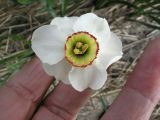For these daffodils fertility theoretically should not exist or be rare, but in reality we find many fertile plants. Poeticus hellenicus (from Carlos van der Veek) for example is autotriploid and with 70 % sprouting pollen highly fertile. The pollen grains are diploid like the pollen grains from tetraploid standard daffodils of division 1-3. DaffSeek shows that it has been used in former times during the development of these tetraploid daffodils. In the recent years it was crossed especially with diploid poeticus varieties. Because it has a small flower diameter it could be of interest now for breeding intermediate tetraploid daffodils
The descendants from crosses of tetraploid daffodils and the diploid N. cyclamineus are allotriploid. That means they have chromosomes from two or more different species . But because their chromosomes in this case are very similar, it can be assumed, that the plants behave like autotriploids concerning the generation of gametes. Often they posess good fertility as can be seen from the hybridizing results of Lawrence Trevanion ( Daffnet: Fertility update – Div 6, December 1, 2014) and for example from Articulate with about 30 % sprouting pollen with one chromosome set of the standard daffodils and one of N. cyclamineus. This constitution seems to be preferred for the gametes of the cyclamineus hybrids. This is also known from older crosses: For example the tetraploid split corona daffodil Tiritomba has the allotriploid Peeping Tom as one of its grandparents.
Another type of allotriploids comes from combining the tetraploid standard daffodils with diploid species for example N. jonquilla, N. assoanus, and N. triandrus. In these cases the differences between the chromosomes are greater. But often you have pollen fertilities of 10 to 20 %. Here also the constitution of the pollen with one chromosome set of the standard daffodil and one of the species seems to be preferred.
Auto- and allotriploids can be used to generate tetraploid daffodils by crossing them with tetraploid daffodils which allready exist. These are the most varieties of standard daffodils of division 1-3. The triploid poeticus hellenicus and the allotriploid cyclamineus hybrids can be used for this purpose. The other allotriploid types can be crossed with the existing few allotetraploid varieties in this field: The allotriploid jonquilla hybrids for example with Hillstar, Limequilla, Quickstep and some others, the triandrus hybrids with Lapwing and Mission Bells. In these groups there are no very different plants and no ones with red crowns. To yield these by the described method some more generations than the first may be necessary. To shorten this process perhaps selfing of a fertile allotriploid or intercrossing of allotriploids can be used: In many cases the triploid or allotriploid plant which generates diploid pollen should also generate diploid eggs and vice versa. By selfing you get allotetraploids. This method, if it functions, does not give rise to as many seeds as the first. But it can be a possibility. I shall try it in spring with a fertile plant of Altruist x N. fernandesii.
Theo


Hi Theo
Very few miniature daffodils on the UK list have colour in the corona and those that have come from standard daffodils crossed with species and are invariably infertile. For that reason I have for a number of years used N. poeticus hellenicus as the pollen parent with species to try and get colour. I find it extremely fertile and hope that I will see the first results in 2015, a cross with N.scaberulus and then will come the test to see if the offspring are fertile. The main problem is the lateness of flowering of hellenicus and so this year I have made a number of crosses using ‘Little Kibler’ as the pollen parent and again have found it very fertile and flowering much earlier than hellenicus. Do you know whether is is a diploid or tetraploid? In addition to using it with species like henriquesii I have also crossed it with hybrids such as N. rupicola x N. watieri in the hope of getting some miniature division 3s.
James Akers
James,
These are very interesting news. Crosses of N. poeticus hellenicus with diploid species should be allotriploid with some fertile plants with gametes composed of one chromosome set of the species and one of the poeticus. Little Kibler may be diploid because it is a little plant with a small flower. In this case the descendants of crosses with species are diploid too. Some will generate unreduced gametes. You can send pollen of Little Kibler to me in spring. Perhaps by determining the pollen volume it can be decided, whether it is diploid or tetraploid.
Theo